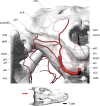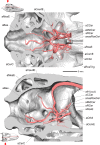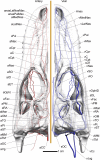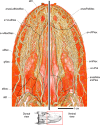Vascular patterns in the heads of crocodilians: blood vessels and sites of thermal exchange
- PMID: 27677246
- PMCID: PMC5108159
- DOI: 10.1111/joa.12539
Vascular patterns in the heads of crocodilians: blood vessels and sites of thermal exchange
Abstract
Extant crocodilians are a highly apomorphic archosaur clade that is ectothermic, yet often achieve large body sizes that can be subject to higher heat loads. Therefore, the anatomical and physiological roles that blood vessels play in crocodilian thermoregulation need further investigation to better understand how crocodilians establish and maintain cephalic temperatures and regulate neurosensory tissue temperatures during basking and normal activities. The cephalic vascular anatomy of extant crocodilians, particularly American alligator (Alligator mississippiensis) was investigated using a differential-contrast, dual-vascular injection technique and high resolution X-ray micro-computed tomography (μCT). Blood vessels were digitally isolated to create representations of vascular pathways. The specimens were then dissected to confirm CT results. Sites of thermal exchange, consisting of the oral, nasal, and orbital regions, were given special attention due to their role in evaporative cooling and cephalic thermoregulation in other diapsids. Blood vessels to and from sites of thermal exchange were studied to detect conserved vascular patterns and to assess their ability to deliver cooled blood to neurosensory tissues. Within the orbital region, both the arteries and veins demonstrated consistent branching patterns, with the supraorbital, infraorbital, and ophthalmotemporal vessels supplying and draining the orbit. The venous drainage of the orbital region showed connections to the dural sinuses via the orbital veins and cavernous sinus. The palatal region demonstrated a vast plexus that comprised both arteries and veins. The most direct route of venous drainage of the palatal plexus was through the palatomaxillary veins, essentially bypassing neurosensory tissues. Anastomotic connections with the nasal region, however, may provide an alternative route for palatal venous blood to reach neurosensory tissues. The nasal region in crocodilians is probably the most prominent site of thermal exchange, as it offers a substantial surface area and is completely surrounded by blood vessels. The venous drainage routes from the nasal region offer routes directly to the dural venous sinuses and the orbit, offering evidence of the potential to directly affect neurosensory tissue temperatures. The evolutionary history of crocodilians is complex, with large-bodied, terrestrial, and possibly endothermic taxa that may have had to deal with thermal loads that likely provided the anatomical building-blocks for such an extensive vascularization of sites of thermal exchange. A clear understanding of the physiological abilities and the role of blood vessels in the thermoregulation of crocodilians neurosensory tissues is not available but vascular anatomical patterns of crocodilian sites of thermal exchange indicate possible physiological abilities that may be more sophisticated than in other extant diapsids.
Keywords: blood vessels; cephalic; crocodilian; thermoregulation; vasculature.
© 2016 Anatomical Society.
Figures














Similar articles
-
Vascular Patterns in Iguanas and Other Squamates: Blood Vessels and Sites of Thermal Exchange.PLoS One. 2015 Oct 14;10(10):e0139215. doi: 10.1371/journal.pone.0139215. eCollection 2015. PLoS One. 2015. PMID: 26466378 Free PMC article.
-
Avian Cephalic Vascular Anatomy, Sites of Thermal Exchange, and the Rete Ophthalmicum.Anat Rec (Hoboken). 2016 Nov;299(11):1461-1486. doi: 10.1002/ar.23375. Epub 2016 Sep 4. Anat Rec (Hoboken). 2016. PMID: 27258923
-
Vascular Patterns in the Heads of Dinosaurs: Evidence for Blood Vessels, Sites of Thermal Exchange, and Their Role in Physiological Thermoregulatory Strategies.Anat Rec (Hoboken). 2020 Apr;303(4):1075-1103. doi: 10.1002/ar.24234. Epub 2019 Oct 16. Anat Rec (Hoboken). 2020. PMID: 31618532
-
A review of venipuncture sites in Alligator mississippiensis with anatomical description of a novel venipuncture site.Anat Rec (Hoboken). 2022 Oct;305(10):3031-3036. doi: 10.1002/ar.24995. Epub 2022 Jun 9. Anat Rec (Hoboken). 2022. PMID: 35678298 Review.
-
Can Xenobiotics Alter the Sex Ratio of Crocodilians in the Wild?Sex Dev. 2021;15(1-3):179-186. doi: 10.1159/000515724. Epub 2021 Jun 23. Sex Dev. 2021. PMID: 34161954 Review.
Cited by
-
An exceptional neurovascular system in abelisaurid theropod skull: New evidence from Skorpiovenator bustingorryi.J Anat. 2022 Apr;240(4):612-626. doi: 10.1111/joa.13258. Epub 2020 Jun 22. J Anat. 2022. PMID: 32569442 Free PMC article.
-
Convoluted nasal passages function as efficient heat exchangers in ankylosaurs (Dinosauria: Ornithischia: Thyreophora).PLoS One. 2018 Dec 19;13(12):e0207381. doi: 10.1371/journal.pone.0207381. eCollection 2018. PLoS One. 2018. PMID: 30566469 Free PMC article.
-
Anatomy and relationships of the early diverging Crocodylomorphs Junggarsuchus sloani and Dibothrosuchus elaphros.Anat Rec (Hoboken). 2022 Oct;305(10):2463-2556. doi: 10.1002/ar.24949. Epub 2022 Jun 14. Anat Rec (Hoboken). 2022. PMID: 35699105 Free PMC article.
-
A review of the carotid artery and facial nerve canal systems in extant turtles.PeerJ. 2021 Jan 21;8:e10475. doi: 10.7717/peerj.10475. eCollection 2021. PeerJ. 2021. PMID: 33552706 Free PMC article.
-
Evidence for a novel cranial thermoregulatory pathway in thalattosuchian crocodylomorphs.PeerJ. 2023 May 2;11:e15353. doi: 10.7717/peerj.15353. eCollection 2023. PeerJ. 2023. PMID: 37151298 Free PMC article.
References
-
- Almeida L, Campos R (2011) A systematic study of the brain base arteries in the broad‐snouted caiman (Caiman latirostris). J Morphol Sci 28, 62–68.
-
- Barbour HR, Archer MA, Hart NS, et al. (2002) Retinal characteristics of the ornate dragon lizard, Ctenophorus ornatus . J Comp Neurol 450, 334–344. - PubMed
-
- Baumel JJ (1975) Aves: heart and blood vessels In: Sisson and Grossman's the Anatomy of the Domestic Animals (ed. Getty R.), pp. 1968–2003. Philadelphia: W.B. Saunders.
-
- Baumel JJ (1993) Systema cardiovasculare In: Sisson and Grossman's the Anatomy of the Domestic Animals (ed. Getty R.), pp. 407–476. Philadelphia: W.B. Saunders.
Publication types
MeSH terms
LinkOut - more resources
Full Text Sources
Other Literature Sources

